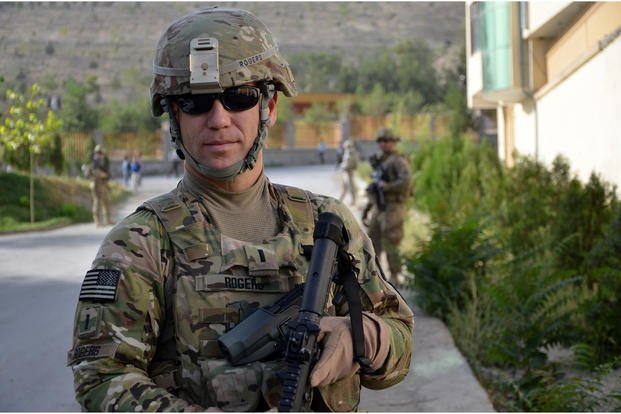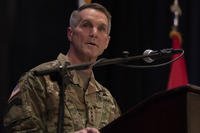HERAT PROVINCE, Afghanistan (USASOC News Service, Oct. 21, 2013) -- The 5th Special Forces Group (Airborne) was activated in September 1961. It is one of five such groups and a highly decorated special operations unit in the U.S. Army. The unit originally was formed during the cold war, specializing in teaching foreign fighters in guerrilla warfare tactics to topple corrupt regimes.
The group served a key role in Afghanistan's fight for freedom by being the first soldiers on the ground in Afghanistan after the 9/11 attacks. These elite warriors demonstrated their ability to adapt and overcome the challenges of being a completely expeditionary force with no infrastructure by working with Afghan tribal armies to overthrow the Taliban's regime.
The group's 2nd Battalion has spent the past seven months serving as the Special Operations Task Force -- West headquarters, a subcomponent of the Combined Joint Special Operations Task Force -- Afghanistan. The SOTF combines special operations members from the U.S. Army, Navy, Marine Corps and Air Force.
The Afghans are beating the Americans. The Herat province locals shout to each other in Pashto and Dari as they maneuver across a field of sand, rock and broken glass. The American Special Forces members are doing their best to keep up in the desert's September evening heat. "Go left," yells one soldier, attempting to organize a last-second defense against the Afghans. The SOTF warrant operations officer's teammates hear the command but don't respond in time. An Afghan player brings his foot forward, and the ball flies inches out of reach of the American team's goalie. The Afghans celebrate together. The score is now Afghans 2, Americans 0.
One of the American soccer players sits down over the edge of a drainage ditch along a nearby road. He watches the game, recovering from his time on the field earlier. Between breathes, he explains that the sport is what has brought many of the American Special Forces members together with their Afghan counterparts. "This is one place we build relationships," he says. "This is where we can earn their trust."
That trust and those friendships brought the Afghan National Army's 2nd Special Operations Brigade from where it was in April 2013 to being today's dominant force in western Afghanistan. The Afghan Commandos, elite soldiers specializing in quick and surgical strikes against the Taliban, once worked side by side with their American special operations counterparts during missions to some of Afghanistan's most remote and rural villages. But Commandos now plan, lead and coordinate entire operations on their own.
Expectation Management
The 2nd Special Operations Brigade originally was designed to direct decentralized operations for the kandaks, subordinate units similar to U.S. Army battalions. "[They] didn't have the connectivity to do that," the SOTF's operations warrant officer said.
The brigade is a relatively new concept to the Afghan National Army Special Operations Command. The Special Operations Kandaks reported to ANA corps or divisions for everything from logistics to operations during their infancy. That extra layer of management was not just confusing for the SOK and ANASOC commanders, but also for the new brigade's staff officers.
"The brigade didn't really understand what its role was. So we came in and assisted them in redefining it," SOTF's operations warrant officer said. He brings his hands up to his face and slides them to meet under his chin, "What people don't understand is ... the brigade just stood up. It's expectation management. It takes time."
The 20-year Special Forces veteran comments on how things have changed over the past 12 years in Afghanistan. He describes a "Hey, come with me ... let's go hit some targets" ideology that evolved into a partnership, helping the Afghans develop their own systems.
Their Own Systems
Commander update briefings are one way that American mentors monitor the brigade's progress. Every morning, officers from each section within the unit's headquarters come together to tell the brigade commander about their progress over the past 24 hours.
The SOTF mentors are sitting in the tactical operations center's back row. Each soldier and mentor specialize in teaching one particular section of the brigade's staff. These men have been working with the Afghans every day for the past six months.
The briefing begins with 2nd SOB's chief of staff, Col. Naeim, calling the room to attention and greeting them all. "As-Salaam Alaikum." Peace be with you all.
The staff officers and American instructors respond in unison, "Wa-Alaikum-Salaam." (And also with you).
Naeim takes his seat at the front of the operations center, listening to each officer's brief about their section's operations over the past 24 hours.
The American mentors take notes while they listen to their Afghan partners' briefings. They already know what has happened over the past 24 hours. The Americans are more interested in seeing how their counterparts relay that information to their commander.
One by one, each section's representative tells the chief of staff about training conducted, reports filed and issues resolved or unresolved. He's impressed, congratulating each on their work since the last briefing.
The logistics sergeant is the next to brief. He talks softly, and the chief of staff tells him to speak up and stop mumbling to himself. The sergeant mentions a vehicle that was damaged severely and needs repairs, but he's unable to explain exactly how it was damaged.
"Go find out why it is broken." Naeim tells the sergeant.
One of the American mentors turns the situation into a lesson for the rest. He waits until the briefing is over and makes his way to the front of the room. "The colonel is a nice guy; he's not going to shoot you. Come to the center, speak to him in a voice that can be heard and make your point."
The Afghans nod in agreement.
"Coming in as a mentor, you need to have an open mind, and you also have to do expectation management," says the Special Forces leader. "You'll take two steps forward one day ... and then you'll fall back a step. There's times when you're going to be frustrated, but you have to be able to push yourself back [from the situation] and get perspective on the bigger picture that we are making progress."
Progress
All the hard work that U.S. Special Forces training teams put into coaching and guiding Afghan special operations is paying off. As American forces take a more "hands-off" approach and Afghan forces to plan and coordinate operations, the 2nd SOB staff and soldiers become more confident in their own ability to sustain the fight against the Taliban.
The brigade consists of the 3rd, 4th, 7th, and 9th Special Operations Kandaks; each with their own areas of responsibility throughout western and southwestern Afghanistan.
The 9th SOK conducted their first all-Afghan helicopter assault mission in early September during a cordon and search operation in Obeh District's Shurgerd village. This mission demonstrated the progress the brigade has made in logistics, operations and their ability to coordinate with other elements of Afghanistan's armed forces.
The brigade's 4th SOK recently assumed control of Village Stability Platform Parmakan, located deep within Shindand District's Zerekoh valley, an area long considered an insurgent stronghold. Commandos stationed at the outpost now rely completely on their own ability to defend the position and the valley against armed militants.
These Afghan Commandos also arrested infamous drug lord Mohhamad Daud during a dynamic raid, effectively cutting the head off of a western Afghanistan narcotics syndicate.
These and other achievements have earned the Commandos praise from their superiors in the brigade and provincial Afghan government officials whom are learning the value of Afghan special operations forces.
Brigade Operations Officer Col. Mir Abdullah smiles as he talks about how the Taliban fighters run after seeing the "Red Berets", the coveted sign of the Afghan Commando.
The 4th SOK commander Lt. Col. Saifullah Najribi proudly tells everyone he meets about the trust he has in his soldiers. His voice grows loud and stern, describing his elite warriors' superior abilities in battle and how effectively the Commandos tackle any situation. He's so certain of victory that he tells his Commandos that wearing their uniform with pride and a sense of patriotism is all they need to defeat their enemy.
The Next Step
The call for evening prayer rings out across the air base after the sun has set, the game is over. The final score is Afghans 3, Americans 1.
Everyone congratulates one another while the Americans promise the next game will be different. The Afghans smile and nod in agreement. "We will see," the Afghan team captain said.
These Afghan warriors have risen from the ranks of ordinary soldiers to join a unique community inside their military. They've successfully toppled terrorists and crime lords, completely changing the atmosphere of western Afghanistan in little more than six months. Their commitment to creating a safer country for future generations drives them to excellence. There is little question in their minds that they will win the future battles ahead.
Want to Know More About the Military?
Be sure to get the latest news about the U.S. military, as well as critical info about how to join and all the benefits of service. Subscribe to Military.com and receive customized updates delivered straight to your inbox.











